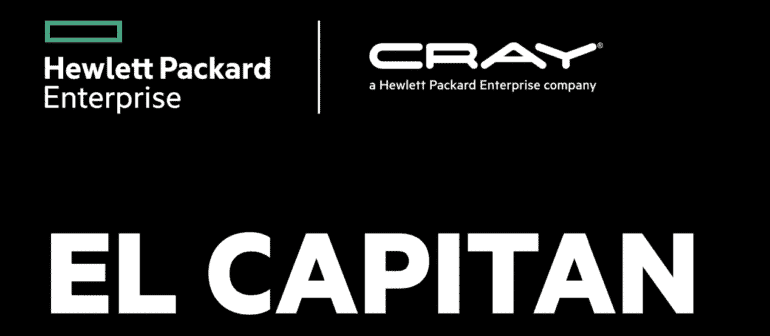Hewlett Packard Enterprise (HPE) today announced that it will deliver the world’s fastest exascale-class supercomputer for the U.S. Department of Energy’s (DOE) National Nuclear Security Administration (NNSA) at a record-breaking speed of 2 exaflops – 10X faster than today’s most powerful supercomputer.
The new system, which the DOE’s Lawrence Livermore National Laboratory (LLNL) has named El Capitan, is expected to be delivered in early 2023 and will be managed and hosted by LLNL for use by the three NNSA national laboratories: LLNL, Sandia National Laboratories, and Los Alamos National Laboratory.
HPE is optimizing the DOE’s El Capitan to power complex and time-consuming 3D exploratory simulations for NNSA missions that today’s state-of-the-art supercomputers cannot successfully manage.
The DOE’s El Capitan will use next-generation AMD EPYC processors, codenamed “Genoa” featuring the “Zen 4” processor core, next-generation AMD Radeon Instinct GPUs, based on a new compute-optimized architecture, and the 3rd Generation AMD Infinity Architecture, which will provide a high-bandwidth, low latency connection between the CPUs and GPUs.
Table of Contents
Strengthening Nation’s Nuclear Stockpile, Security and Defense with Exascale Technologies
“As an industry and as a nation, we have achieved a major milestone in computing. HPE is honored to support the U.S. Department of Energy and Lawrence Livermore National Laboratory in a critical strategic mission to advance the United States’ position in security and defense,” said Peter Ungaro, senior vice president, and general manager, HPC and Mission Critical Systems (MCS), at HPE.
HPE’s Cray Shasta technologies, which were built from the ground up to support a diverse set of processor and accelerator technologies to meet new levels of performance and scalability, will enable the DOE’s El Capitan to meet NNSA requirements, which include the NNSA’s Life Extension Program (LEP), a critical part of stockpile stewardship that aims to modernize aging weapons in the U.S. nuclear stockpile that are to remain safe, secure, and effective.
LLNL researchers will use the system to explore new applications that integrate AI and machine learning into HPC workloads and is already applying HPE supercomputing and AI solutions to make breakthroughs in medical and drug research initiatives, including:
Accelerating cancer drug discovery from six years to one year through a partnership with GlaxoSmithKline (gsk), a multinational pharmaceutical company, the National Cancer Institute, and other DOE national laboratories through the ATOM consortium.
Understanding the dynamics and mutations of RAS proteins that are linked to 30% of human cancers by collaborating with The National Cancer Institute and other partner institutions.
Breaking Speed Barrier with 2 Exaflops
Systems like the DOE’s El Capitan are ushering in a new class of supercomputing with exascale-class systems that are 1,000X faster than the previous generation petascale systems first introduced 12 years ago.
The new performance record of 2 exaflops (2,000 petaflops) will be more powerful than the Top 200 fastest supercomputers in the world combined and is an increase of more than 30% from initially projected estimates calculated seven months ago. This was made possible by a new partnership between HPE, AMD and the U.S. DOE to combine HPE’s Cray Shasta system and Slingshot interconnect, a specialized HPC networking solution, with next-generation AMD EPYC processors and next-generation AMD Radeon Instinct GPUs.
“We are pleased to continue our longstanding journey with HPE in co-developing innovative technologies for a range of solutions, and now, for the world’s most powerful, exascale-class supercomputer,” said Forrest Norrod, senior vice president and general manager of the Datacenter and Embedded Solutions Business Group, AMD.
“The exceptional computing power promised by El Capitan, based on HPE’s Cray Shasta architecture, will ensure the NNSA laboratories can continue to excel at their national security missions and make it possible for the U.S. to remain competitive on the global stage in high-performance computing for many years to come,” said Bill Goldstein, director, Lawrence Livermore National Laboratory.
Enhanced Performance for DOE’s El Capitan
Streamlined communication between HPE’s Cray Slingshot interconnects a specialized HPC networking solution and new next-generation AMD Radeon Instinct GPUs that are based on a new compute-optimized architecture for workloads including HPC and AI.
High density compute blades powered by next-generation AMD EPYC processors, codenamed “Genoa” featuring the “Zen 4” processor core
A new approach using accelerator-centric compute blades (in a 4:1 GPU to CPU ratio, connected by the 3rd Gen AMD Infinity Architecture for high-bandwidth, low latency connections) to increase performance for data-intensive AI, machine learning, and analytics needs by offloading processing from the CPU to the GPU.
New LLNL Partnership to Demonstrate Optics in DOE’S El Capitan
HPE is expanding its partnership with LLNL to actively explore HPE optics technologies, a computing solution that uses light to transmit data, to feature in the DOE’s El Capitan.
HPE developed and demonstrated breakthrough optics prototypes that integrate electrical-to-optical interfaces to enable broad use in future classes of system interconnects.
Together, HPE and LLNL are exploring ways to integrate these optics technologies with HPE’s Cray Slingshot for DOE’s El Capitan to transmit more data, more efficiently.
In addition to the DOE’s El Capitan, HPE will deliver the other two U.S DOE exascale systems announced in 2019, Aurora and Frontier.
Over time, HPE will integrate its exascale technologies into its broader HPC product portfolio to deliver supercomputers of any size for every data center, and democratize Exascale Era technologies for broader market uses.

